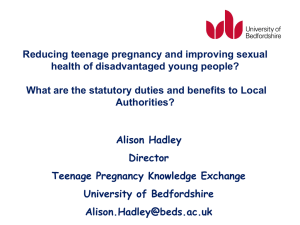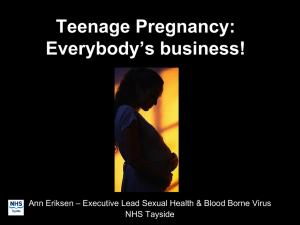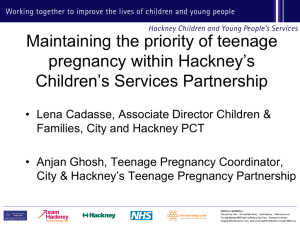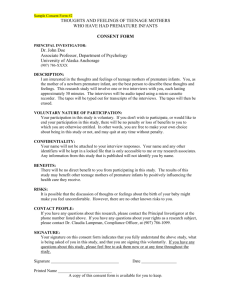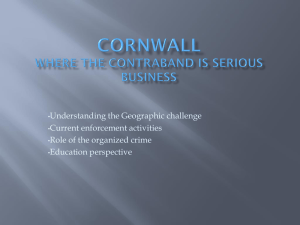EQAULITY IMPACT ASSESSMENTS REVISED CORPORATE MODEL
advertisement
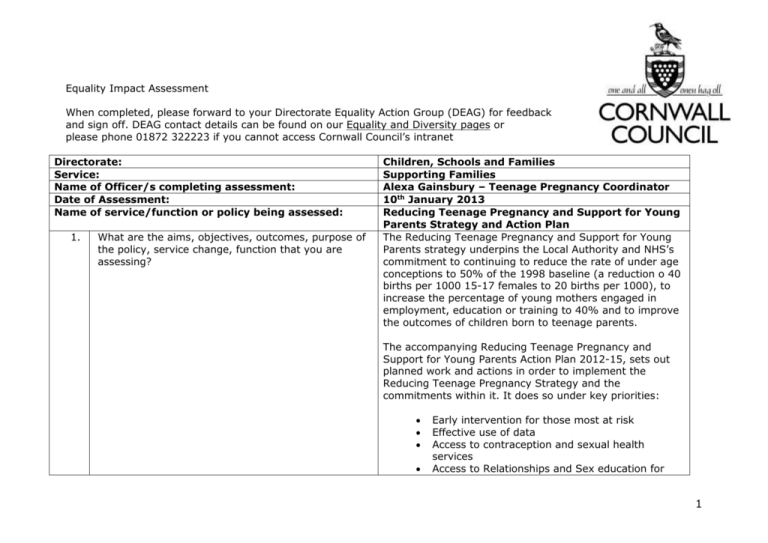
Equality Impact Assessment When completed, please forward to your Directorate Equality Action Group (DEAG) for feedback and sign off. DEAG contact details can be found on our Equality and Diversity pages or please phone 01872 322223 if you cannot access Cornwall Council’s intranet Directorate: Service: Name of Officer/s completing assessment: Date of Assessment: Name of service/function or policy being assessed: 1. What are the aims, objectives, outcomes, purpose of the policy, service change, function that you are assessing? Children, Schools and Families Supporting Families Alexa Gainsbury – Teenage Pregnancy Coordinator 10th January 2013 Reducing Teenage Pregnancy and Support for Young Parents Strategy and Action Plan The Reducing Teenage Pregnancy and Support for Young Parents strategy underpins the Local Authority and NHS’s commitment to continuing to reduce the rate of under age conceptions to 50% of the 1998 baseline (a reduction o 40 births per 1000 15-17 females to 20 births per 1000), to increase the percentage of young mothers engaged in employment, education or training to 40% and to improve the outcomes of children born to teenage parents. The accompanying Reducing Teenage Pregnancy and Support for Young Parents Action Plan 2012-15, sets out planned work and actions in order to implement the Reducing Teenage Pregnancy Strategy and the commitments within it. It does so under key priorities: Early intervention for those most at risk Effective use of data Access to contraception and sexual health services Access to Relationships and Sex education for 1 2. Who implements or delivers the policy, service or function? State if this is undertaken by more than one team, service, and department including any external partners. parents, carers, children and young people Improving outcomes for teenage parents and their children Supporting a skilled workforce The strategy and action plan is delivered by the Local Authority, the NHS Cornwall and the Isles of Scilly and a number of providers, including: Brook The Health Promotion Service Family Nurse Partnership WILD Cornwall College CLEAR Careers South West Young People Cornwall Cornwall Healthy Schools Royal Cornwall Hospital Trust The action plan sets out the planned actions to be undertaken by the Local Authority, the NHS and service providers. 3. Who will be affected by this proposal? For example who are the external/internal customers, communities, partners, stakeholders, the workforce etc. Employees of Cornwall Council and the NHS, contractors of Cornwall Council and the NHS and service users. The following cohorts of service users are most likely to be affected by the proposed strategy: School aged children and young people, up to age 18 The parents and carers of school aged children and young people 2 4. Teenage mothers and fathers and expectant teenagers. What are the likely positive or negative impacts for the School aged children and young people, up to age group/s identified in (3) above? What particular 18 groups are affected more than others and why? Positive: The Strategy and Action Plan sets out a commitment to provide sexual health services and education to young people in Cornwall alongside early intervention for those identified as at risk of poor sexual health and teenage pregnancy. As the strategy and accompanying action plan sets outs out positive support for these cohorts of young people it is envisaged that the impact will be positive. The key objectives for this cohort is that: Young people have access to contraception as appropriate to age and Fraser Competence Young people have access to positive relationship and sex education Young people who are at risk of poor sexual health or risky sexual behaviours are given early support. The plan sets out universal access for all young people and takes into account the need to provide services that are accessible for all. This should have a positive impact on minority groups and those whose geography may leave them isolated. Some young people are more vulnerable than others. Research has highlighted the following as key ‘risk factors’ in terms of early parenthood: • Daughter of a teenage mother 3 • • • • • • • • • • • • Currently a teenage parent Having experienced repeat terminations Looked after child/ Care history Early onset of sexual activity Poor / inconsistent contraceptive use Alcohol & substance misuse Low educational attainment disengagement from school/NEET Low educational aspirations/parents with low educational aspirations Living in a deprived area Involved in Crime Poor emotional Wellbeing Negative: If no strategy and action plan were in place this would have a negative impact on all young people as a driving force to ensure cohesive, integrated services would be missing. However those whose experiences feature the above characteristics, and hence may already be ‘vulnerable’ are likely to experience the greatest negative impact. It is important to note that the law states1 that a young person under the age of thirteen cannot consent to sex. Consequently contraceptive services are not available to young people twelve and under and safeguarding procedures are followed. 1 The parents and carers of school aged children and young people Sexual Offences Act 2003. 4 Positive: The Strategy and Action Plan identifies the need to support parents and carers in their role as educator and carer, supporting young people in making positive choices about sexual activity. National research has highlighted that parents are young people’s preferred source of information yet less than half (40%) receive information from their parents.2 Local research has also identified that parents are not talking to their children about relationships and sex. The strategy and action plan is designed to benefit parents and carers by supporting them to increase their knowledge and skills in engaging young people in this area, in turn this will support positive relationships between parent/carer and child and increased health and wellbeing. Research carried out by Cornwall Council has shown that parents feel more confident and knowledgeable following support. The key objective for this cohort is: Parents and carers are supported and encouraged to support and develop their children’s understanding of healthy relationships Negative: if there were no strategy and action plan then parents would not be offered this opportunity to work together with services in order to support their children and promote positive futures for their families. Consequently they may not know where to turn to for help and advice which could undermine their confidence and leave them feeling unsupported. 2 National Youth Agency, (2010) What Young People think about Advice Information and Guidance, National Youth Agency. 5 Teenage mothers and fathers and expectant teenagers. The plan also sets out additional support for young parents, a cohort that are disadvantaged in their own right and can often feel marginalised from universal services. Due to the factors often present in young parent’s lives, highlighted above, young parents may already be disadvantaged by their prior experiences and current situation, for example, deprivation and poor emotional wellbeing. Again this strategy aims to deliver a positive impact for this group of young people by providing services that mitigate the impact of this disadvantage. They key objectives for this cohort are: Additional support and interventions are in place that support parents to achieve positive outcome for parents and child Ensure that young parents can access timely specialist and universal support Support young fathers to play a positive and active role in their child’s life Negative: Without a strategy and action plan outlying the specific and potential additional needs of this cohort, young parents and their children will not be supported to overcome difficulties that may already be present in their lives and achieve comparable outcomes to their older peers. Specific consideration needs to be given to whether age, sex, sexual orientation, disability, race, ethnic background, religion or belief, gender reassignment status, marital or 6 civil partnership status, pregnancy and maternity status impacts on one’s access to services. This Equality Impact Assessment has highlighted the need to ensure that all the services we commission consider this and consequently all new services providers will be required to complete an Equality Impact Assessment of their service provision. 5. Have the impacts indentified in (4) above been assessed using up to date and reliable evidence and data? Do you need to engage or consult with any identified group/s? If in doubt ask the Community Intelligence Team for guidance. The strategy and action plan has relied on a number of sources of data to identify the needs and potential impact of this strategy and action plan for the above groups. This includes: National data provided detailing the number of conceptions on a quarterly basis. This information is provided by the Office for National Statistics Local NHS data. Detailing the number of conceptions across Cornwall. This data is local and usually contains very small numbers so we are unable to share the information publically. Information collected by Careers South West detailing the percentage of young mothers and young fathers engaged in education, employment or training. Care to Learn Data provided by the Department of Education detailing the number of young parents accessing childcare funding. This data allows us to track our progress against other local authorities. Qualitative research consisting of in-depth interviews with the Young Mums Will Achieve cohort In the developing the strategy and action plan consultation was carried out with the following services and service user groups: 7 - Cornwall’s Teenage Pregnancy Partnership Board. Which includes representation from: • Cornwall Councillor • NHS Cornwall and Isles of Scilly • Cornwall College • Careers South West • Family Nurse Partnership • Supporting Families • Integrated Youth Service • Schools and Achievement • Social Work and Psychology Service • NHS Commissioning - Children Schools and Families Directorate Young Mums Will Achieve service user group WILD young parents Young Father’s project Brook Young people via Cornwall Council Take Over Day Cornwall Health Promotion Cornwall Healthy Schools Plus Cornwall CLEAR project Cornwall SAFE project Cornwall Learning Partnership Council of the Isles of Scilly. 6. Are any of these identified groups considered to be vulnerable? If so have you engaged with or plan to engage with any relevant representative organisation. For example if the impact is likely to affect people with National research has highlighted that the most common factors related to becoming a teenage parent are: • Daughter of a teenage mother • Currently a teenage parent 8 a disability have you engaged with Disability Cornwall? If staff are affected have the unions or staff forums been involved? • • • • • • • • • • • Having experienced repeat Terminations Looked after child/ Care history Early onset of sexual activity Poor / inconsistent contraceptive use Alcohol & substance misuse Low educational attainment disengagement from school/NEET Low educational aspirations/parents with low educational aspirations Living in a deprived area Involved in Crime Poor emotional Wellbeing These risk indicators show that the young people most at risk of poor sexual health and unplanned teenage pregnancy are vulnerable. We also know that young parents, and the children of young parents face poorer outcomes than parents, and children of parents who conceive later. These include: • Teenage mothers are less likely to finish their education and are more likely to live in poverty. • Teenage mothers have three times the rate of post natal depression of older mothers and a higher risk of poor mental health for three years after birth. • Teenage parents are at increased risk of homelessness • Teenage mothers have higher incidences of relationship breakdown and are more likely to be lone parents • Aged 30, those who were young fathers are twice as likely to be unemployed. 9 • • • • Aged 30, those who were young fathers are less likely to be currently living with, or have ever lived with their children. The infant mortality rate for babies born to teenage mothers is 60% higher than for babies born to older mothers. Children of teenage mothers are at increased risk of poverty, low educational attainment, poor housing and poor health and have lower rates of economic activity in adult life Children of teenage mothers are more likely to be teenage parents themselves Qualitative research via in depth interviews has been undertaken with the Young Mothers Will Achieve groups in order to gain feedback regarding their experiences and views of services in order to support service development in the future. Information is still lacking in regards to fathers’ experiences and views. To address this the action plan details plans to extend this research to include young fathers. The Teenage Pregnancy Partnership Board has also contributed to, and will use the outcome of, s Health and Wellbeing questionnaire due to be rolled out to schools across Cornwall in Spring term 2013, to gather the views of young people and direct future service provision. 7. What plans do you have in place, or are developing, that will mitigate the likely identified negative impacts? For example what plans, if any, will be put in place to reduce the impact? Negative impacts were identified for not having a strategy and action plan that brings together work to support young people, parents, carers and young parents. 10 The strategy and action plan has been developed to mitigate the identified negative impacts by: Providing both universal and targeted support to children and young people Ensuring all young people have access to information, education, advice, guidance and contraceptive services Ensuring those who need the support most, due to factors that make them vulnerable, are identified and provided for Supporting parents/carers to develop positive relationships with the children they care for Ensuring different areas are working together to deliver one cohesive plan Services currently being commissioned reflect the need to support young people as a homogenous group, but also address inequalities and key vulnerabilities that have been highlighted by data analysis, service user feedback and research in the area. The Action Plan details how we will continue to provide services that attempt to mitigate the negative impact that geography, background or circumstance may have on young people’s access. A key example of this is the young people’s mobile sexual health bus which has been commissioned to mitigate the negative impacts isolation can have on service access. All new providers will be required to complete an EIA against their service delivery plan in order to monitor the impact of the service and strategy on outcomes for young 11 people, young parents and their children and identify opportunities to further reduce the impact of inequalities in partnership. 8. Do you have plans in place to monitor the impact of the proposals once they have been implemented? The full impact of the decision may only be known after the proposals have been implemented. The Teenage Pregnancy Partnership Board is a multi agency strategic group that holds accountability for the Reducing Teenage Pregnancy and Supporting Teenage Parents Strategy and Action Plan. The TPP board is chaired by the Associate Director for Public Health who also chairs the Cornwall Sexual Health Partnership Group, ensuring integrated practice. The TPP board will monitor the impact of the strategy and action plan using the ‘evidence’ section of the action plan. This sets out specific actions and alongside required outcomes to evidence that action. It includes a number of key targets for 2012/13: 40% of young parents to be engaged in education, employment and training by year end 2012/13 Mobile sexual health provision to achieve 720 visits by year end 2012/13 3000 new registrations to the C Card scheme by April 2013 CAFs to be offered to 50% of new young families in 2013 6000 unique hits achieved by information website The strategy and action plan covers 2012-15 and the TPP board will annually set new targets and direct the work of the action plan. 12 Conception rates and education rates for young mothers are included in the Supporting Families balance scorecard and are reported on a monthly basis. Failure to deliver against the strategy and action plan is considered in the Supporting Families Service risk log. All commissioned services are monitored in line with Cornwall Council’s contract management toolkit and are monitored against outcomes. This information is then reported back to the Teenage Pregnancy Partnership Board. 13 What course of action does this EIA suggest you take? More than one of the following may apply Outcome 1: No major change required. The EIA has not identified any potential for discrimination or adverse impact and all opportunities to promote equality have been taken Outcome 2: Adjust the policy to remove barriers identified by the EIA or better promote equality. Are you satisfied that the proposed adjustments will remove the barriers identified? Outcome 3: Continue the policy despite potential for adverse impact or missed opportunities to promote equality identified. You will need to ensure that the EIA clearly sets out the justifications for continuing with it. You should consider whether there are sufficient plans to reduce the negative impact and/or plans to monitor the actual impact (see questions below) Outcome 4: Stop and rethink the policy when the EIA shows actual or potential unlawful discrimination Summary of your proposals (Copy and paste into any report for CLT, Cabinet and Council) What are the key impacts – both negative and positive What course of action are you advising as a result of this EIA Are there any particular groups affected more than others The Strategy and accompanying Action Plan intend to be positive. The key priorities of the Reducing Teenage Pregnancy and Support for Teenage Parents Strategy and Action Plan are: Early intervention for those most at risk Effective use of data Access to contraception and sexual health services Access to Relationships and Sex education for parents, carers, children and young people Improving outcomes for teenage parents and their children Supporting a skilled workforce Increasing the number of young mothers in education, employment and training to 40% Reducing the teenage conception rate by 50% from the 1998 baseline (i.e. conceptions reduced to 20 per 1000). This is based on key factors the Government has highlighted as effective in reducing Teenage Pregnancy3 3 DH and DCSF: 2010. 14 Specific Actions arising for the EIA are: Implementation of the Reducing Teenage Pregnancy and Support for Young Parents Strategy and Action Plan. Requirement placed on all new service providers commissioned by the Teenage Pregnancy Partnership Board to undertake an Equality Impact Assessment Increasing scope of forthcoming service user research project to include young fathers. The focus of the Strategy and accompanying Action Plan is the reduction of teenage conceptions and the promotion of positive outcomes for young parents and their children. As a result the groups of people most likely to be affected are: - Children and young people up to the age of eighteen Parents and carers of children and young people Teenage parents and expectant teenagers The children of teenage parents DEAG Sign – Off Name: Anna Mankee-Williams Date: 21 February 2013 Comments/Action Required: (For Corporate E & D use only) Published date: When the Equality Impact Assessment is completed send to equality@cornwall.gov.uk for publication 15 16


